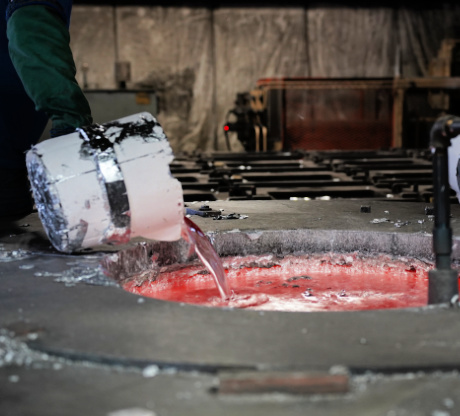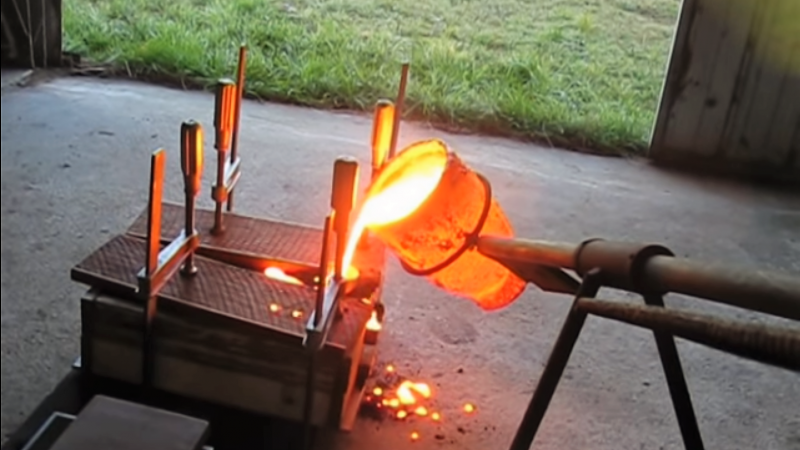Exploring the Crucial Applications and Use Aluminum Foundry in Modern Manufacturing
Aluminum factories play a crucial function in modern production, offering diverse markets with their one-of-a-kind residential properties. From automobile parts that improve gas effectiveness to aerospace structures that focus on weight, light weight aluminum's adaptability appears. Its applications encompass construction and customer electronics, highlighting its toughness and energy effectiveness. The technologies in aluminum spreading methods and future fads necessitate a closer examination, as they may redefine its impact on production.
The Duty of Aluminum Foundries in Automotive Manufacturing
As the automotive sector significantly focuses on light-weight products to boost gas efficiency and performance, light weight aluminum shops have ended up being essential contributors to manufacturing processes. These factories focus on generating elements that satisfy the rigorous demands of contemporary automobiles, such as engine blocks, transmission housings, and structural components. Light weight aluminum's positive properties-- such as high strength-to-weight ratio, corrosion resistance, and superb thermal conductivity-- make it a suitable selection for automotive applications.
Additionally, aluminum shops make use of advanced casting techniques, including die spreading and sand spreading, to create complex and long lasting components. This capacity permits manufacturers to optimize styles for performance while decreasing weight. Making use of aluminum additionally sustains sustainability goals, as it is extremely recyclable and decreases energy consumption in lorries. By helping with the integration of light weight aluminum right into automotive layout, factories play an essential function in shaping the future of the vehicle market, advertising effectiveness and development across the board.
Aerospace Applications: Lightweight Solutions for Trip
Aluminum foundries play a substantial function in the aerospace market, where the need for light-weight materials is extremely important for enhancing gas effectiveness and efficiency in airplane. The special residential properties of light weight aluminum, including its high strength-to-weight proportion and deterioration resistance, make it an excellent selection for different aerospace parts. These elements include structural parts, engine coverings, and landing gear, which contribute to total airplane performance.
Making use of aluminum alloys, specifically those developed with advanced spreading techniques, permits the manufacturing of complex layouts and intricate forms while decreasing weight. Furthermore, aluminum's recyclability straightens with the aerospace market's sustainability goals, lowering ecological impact. With constant innovations in light weight aluminum shop technologies, suppliers can optimize production processes, leading to increased performance and lowered costs. As the aerospace industry significantly prioritizes technologies that boost efficiency, aluminum factories will certainly continue to be important to creating lightweight solutions for modern trip.
Building and Building And Construction: Enhancing Structural Honesty
In the structure and building sector, a considerable emphasis is put on improving architectural integrity with using aluminum. Understood for its high strength-to-weight ratio, light weight aluminum offers durability without compromising on weight, which is vital in modern architectural layouts. Its resistance to rust better assures longevity, making it an ideal product for various architectural elements, including beam of lights, frameworks, and cladding.
Light weight aluminum likewise helps with cutting-edge style opportunities, permitting architects and designers to produce visually pleasing frameworks while preserving security criteria. The product's convenience enables its application in both business and household jobs, from high-rises to bridges. Furthermore, improvements in aluminum foundry techniques have enhanced the precision of light weight aluminum parts, ensuring they satisfy rigorous building regulations. Overall, the assimilation of aluminum in building not only boosts architectural integrity yet likewise adds to sustainable structure practices, provided its recyclability and energy-efficient production methods.
Customer Electronics: The Rise of Light Weight Aluminum in Modern technology
In the domain name of customer electronics, light weight aluminum has actually obtained prestige as a result of its light-weight style advantages and superior thermal conductivity. This shift not just enhances product portability however also improves device performance by successfully dissipating heat. As modern technology remains to evolve, the function of aluminum in producing smooth and reliable gadgets is significantly substantial.
Light-weight Layout Advantages
As customer electronics advance, the demand for lightweight yet sturdy products has actually surged, making light weight aluminum a progressively popular option amongst makers. Its reduced thickness enables the production of smooth gadgets that are simple to utilize and carry, substantially enhancing portability. The strength-to-weight ratio of aluminum warranties that items can endure day-to-day deterioration without endangering efficiency. In addition, the pliability of light weight aluminum enables makers to create elaborate forms and types, even more contributing to cutting-edge visual appeals and capability. This light-weight feature additionally plays an essential function in power performance, as lighter devices call for much less power to operate. Because of this, light weight aluminum not just satisfies the evolving aesthetic needs but additionally lines up with the modern-day focus on sustainability in customer electronics.
Thermal Conductivity Perks
Thermal conductivity is a critical variable in the efficiency of consumer electronic devices, and light weight aluminum excels in this domain name. Its high thermal conductivity enables efficient heat dissipation, which is crucial for keeping optimal operating temperature levels in devices such as mobile phones, laptop computers, and gaming consoles. By facilitating fast warmth transfer away from sensitive elements, light weight aluminum aids avoid overheating, thus enhancing performance and lengthening device long life. The lightweight nature of aluminum complements its thermal residential or commercial properties, making it an optimal selection for mobile modern technology. As suppliers increasingly prioritize efficiency and energy effectiveness, light weight aluminum's duty in thermal management ends up being a lot more substantial, resulting in its growing adoption in modern electronic layouts. This fad emphasizes light weight aluminum's significance in customer electronics development.
Marine Market: Rust Resistance in Harsh Atmospheres
Deterioration resistance is a critical element in the aquatic market, where devices and structures are consistently subjected to harsh saltwater atmospheres. Light weight aluminum, specifically in its alloy types, provides substantial advantages in this regard. Its all-natural oxide layer gives a safety obstacle that avoids deterioration, making it suitable for vessels, docks, and other aquatic applications.
Marine-grade light weight aluminum alloys, such as 5083 and 6061, are particularly made to withstand the harsh effects of saltwater and climatic conditions. These alloys not just withstand rust however likewise keep structural integrity and toughness with time. Applications vary from hulls and superstructures of ships to components in offshore platforms.
The lightweight nature of light weight aluminum additional improves its viability, allowing enhanced fuel efficiency and simplicity of handling - Aluminum Casting. As the marine market continues to concentrate on sturdiness and performance, light weight you can try this out aluminum continues to be a necessary material choice for resisting corrosion popular aquatic settings
Developments in Aluminum Casting Techniques
While standard light weight aluminum spreading techniques have served the industry well, current technologies are changing the landscape of aluminum production. Techniques such as 3D printing of molds and cores are gaining grip, permitting quick prototyping and lowered preparations. This advancement makes it possible for producers to develop intricate geometries that were formerly hard to accomplish with conventional spreading methods. In addition, improvements in die-casting technology, consisting of using high-pressure die-casting (HPDC), have actually improved the precision and surface area finish of actors light weight aluminum components, leading to improved efficiency in various applications.
The fostering of investment casting has enabled for better style freedom and minimized material waste. Innovations in alloy structures are additionally considerable, as they enhance mechanical residential properties and rust resistance. In general, these advancements not just simplify production processes however likewise add to even more lasting techniques within the aluminum foundry sector, making it adaptable to the evolving demands of modern manufacturing
Future Trends in Aluminum Factory Production
The future of aluminum shop production is positioned for significant improvement through automation, enhancing efficiency and accuracy in manufacturing processes. Lasting practices are significantly ending up being a priority, as foundries seek to minimize their ecological effect while fulfilling growing regulative demands. Additionally, improvements in alloy growth will certainly make it possible for the development of more powerful, lighter materials customized for varied read review applications, driving innovation in the market.
Automation in Factory Processes

Lasting Production Practices
A growing focus on lasting production practices is reshaping the future of aluminum foundry manufacturing. Sector leaders are increasingly taking on energy-efficient innovations and recycling efforts to lessen waste and reduce carbon impacts. The usage of recycled light weight aluminum considerably reduces power intake contrasted to primary aluminum production, making it a favored choice for eco conscious producers. Furthermore, ingenious spreading techniques are being established to improve product effectiveness and decrease exhausts. Business are also investing in sustainable energy sources, such as solar and wind, to power their operations sustainably. aluminum casting company. By integrating these methods, the light weight aluminum factory sector not just satisfies regulative needs but additionally reacts to customer need for greener items, eventually paving the way for a much more lasting manufacturing landscape
Advanced Alloy Advancement
Developments in aluminum alloy growth are set to play a significant duty in the future of shop manufacturing, especially as sustainability and efficiency needs This Site rise. The sector is increasingly focusing on producing high-strength, lightweight alloys that can withstand extreme problems while minimizing ecological impact. Researchers are checking out ingenious make-ups, such as aluminum-lithium and aluminum-scandium alloys, which guarantee boosted mechanical buildings and minimized weight. In addition, the integration of advanced manufacturing methods, consisting of additive manufacturing and precision casting, permits more facility geometries and lowered product waste. As governing stress and customer preferences change towards greener alternatives, the advancement of recyclable and energy-efficient alloys will certainly be necessary. The future landscape of aluminum foundry production rests on these innovations in alloy innovation.

Frequently Asked Questions
What Are the Environmental Influences of Aluminum Foundry Operations?
Light weight aluminum shop operations can lead to considerable ecological influences, including greenhouse gas emissions, energy usage, and waste generation. Furthermore, improper monitoring of contaminants might result in soil and water contamination, affecting local environments and communities.
Exactly How Does Light Weight Aluminum Recycling Affect Shop Processes?
Light weight aluminum recycling enhances shop procedures by supplying a cost-efficient basic material, minimizing power intake and emissions. This sustainable practice raises performance, lessens waste, and supports the round economic climate, benefiting both manufacturers and the setting.
What Security Procedures Are Implemented in Light Weight Aluminum Foundries?
Aluminum foundries apply different safety steps, including individual safety tools, proper ventilation systems, normal security training, fire prevention procedures, and devices upkeep treatments to minimize threats and guarantee a safe functioning environment for all staff members.
Exactly How Do Foundries Make Certain Quality Control in Aluminum Spreading?
Factories guarantee quality assurance in aluminum casting via rigorous material inspections, accurate temperature tracking, standard procedures, and normal testing of cast products. These actions aid preserve uniformity, lower issues, and meet sector specs properly.
What Are the Expense Consider Light Weight Aluminum Shop Manufacturing?
Expense elements in light weight aluminum shop production consist of resources rates, energy consumption, labor prices, tools maintenance, and overhead costs. Additionally, manufacturing quantity and intricacy of layouts considerably affect total manufacturing costs and earnings.
As the automotive industry significantly prioritizes lightweight products to improve fuel effectiveness and efficiency, aluminum factories have actually ended up being essential factors to manufacturing procedures. Light weight aluminum shops play a significant duty in the aerospace field, where the need for lightweight materials is vital for enhancing fuel efficiency and efficiency in airplane. Additionally, developments in light weight aluminum factory strategies have boosted the precision of light weight aluminum parts, ensuring they meet rigid structure codes. While standard aluminum casting methods have offered the sector well, current innovations are transforming the landscape of light weight aluminum production. The use of recycled light weight aluminum significantly lowers energy usage compared to key aluminum manufacturing, making it a preferred option for environmentally aware manufacturers.